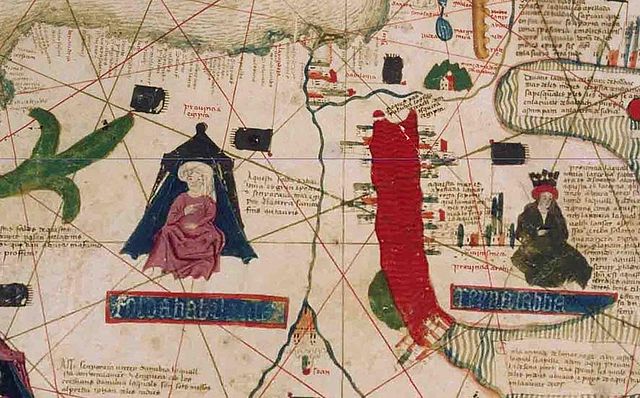Persians, Ports, and Pepper: The Red Sea Trade in Late Antiquity
By Bryan Ladds
Master’s Thesis, University of Ottawa, 2015
Abstract: There has been an increased interest in Romeʼs connections with the Far East over the course of the last 20 years. This has resulted in the publication of many articles and monographs about the Roman involvement in the Red Sea which was the key maritime region linking the Far East with the West. This thesis synthesizes the recent scholarship on the Red Sea trade in Late Antiquity by merging all of the most up to date information into a concise narrative. In order to accomplish this, three major sources of information have been analyzed. Firstly, the historical time frame of all of the major regions of the Red Sea including Egypt, Aksum, and Himyar have been laid out in a straight forward narrative. This offers the most pertinent background information for the development of Red Sea trade.
Secondly, the most up to date archaeological evidence has been incorporated into a description of the ancient maritime trade infrastructure of the Red Sea and Indian Ocean. The archaeological evidence broadens our knowledge of the roads through the Eastern Desert of Egypt, the ports of the Red Sea, and the development of the Indian subcontinent more generally. Thirdly, this thesis builds on all of the historical as well as archaeological data and attempts to quantify the impact of Red Sea trade on the Late Antique Roman Empire both economically and culturally. This synthesis helps to elucidate the growing conception among Late Antique scholars that the Roman Empire was far more interconnected with its eastern neighbours. This further nuances the role which outside forces had on the evolution of the Late Antique world.
Introduction: As the study of Late Antiquity has blossomed over the course of the last generation, the transition from Antiquity to the Middle Ages has been reevaluated and rehabilitated. The cornerstone of Late Antique studies traditionally centred around The Decline and Fall of the Roman Empire written by Edward Gibbon in the late 18th century. This massive work, as the title indicates, painted a picture of the degradation of the Roman Empire from its height under the Antonine dynasty in the 2nd century to its eventual destruction in the Middle Ages in 1453. The view that Late Antiquity was a period of decline was reversed in 1971 by the seminal work of Peter Brown entitled The World of Late Antiquity. Since the publication of this work scholars have reexamined Late Antiquity as a period of continuation and transformation. This paradigm shift has reopened interest into Late Antique studies and prompted inspiring research into the often neglected period. Furthermore, over the last 40 years dozens of archaeological projects have been initiated with the express intent of examining Late Antique remains. Additionally, the rich textual tradition of the later Roman Empire has been reexamined and new texts have steadily been published and made available to scholars and the general public everywhere. The discoveries of the last several decades have reshaped the understanding of a wide range of Late Antique topics, and by extension have broadened comprehension of Antiquity and the Middle Ages


 The study of Rome’s Eastern trade has likewise been significantly altered by new information about the Eastern Roman Empire in Late Antiquity. Traditionally, Rome’s contacts with the Far East were believed to have disintegrated by the 4th century, with the Sassanids and the Aksumites dictating trade as Constantinople was beset by barbarians and Egypt was raided by nomads. Recent research has gone a long way in reversing this idea. Trade in Late Antiquity, especially in the Eastern Empire, continued through the collaboration between the Romans and their neighbours in the more globally diverse and efficient exchange networks of the Byzantine world. A major component of the commercial links with the East was the sea route through the Red Sea. Goods which did not come from the overland Silk Road, which passed through Persia and Palmyra, necessarily had to utilize the maritime route which connected India and Egypt by means of the Indian Ocean and Red Sea.
The study of Rome’s Eastern trade has likewise been significantly altered by new information about the Eastern Roman Empire in Late Antiquity. Traditionally, Rome’s contacts with the Far East were believed to have disintegrated by the 4th century, with the Sassanids and the Aksumites dictating trade as Constantinople was beset by barbarians and Egypt was raided by nomads. Recent research has gone a long way in reversing this idea. Trade in Late Antiquity, especially in the Eastern Empire, continued through the collaboration between the Romans and their neighbours in the more globally diverse and efficient exchange networks of the Byzantine world. A major component of the commercial links with the East was the sea route through the Red Sea. Goods which did not come from the overland Silk Road, which passed through Persia and Palmyra, necessarily had to utilize the maritime route which connected India and Egypt by means of the Indian Ocean and Red Sea.
Click here to read this thesis from the University of Ottawa
Sponsored Content


Persians, Ports, and Pepper: The Red Sea Trade in Late Antiquity
By Bryan Ladds
Master’s Thesis, University of Ottawa, 2015
Abstract: There has been an increased interest in Romeʼs connections with the Far East over the course of the last 20 years. This has resulted in the publication of many articles and monographs about the Roman involvement in the Red Sea which was the key maritime region linking the Far East with the West. This thesis synthesizes the recent scholarship on the Red Sea trade in Late Antiquity by merging all of the most up to date information into a concise narrative. In order to accomplish this, three major sources of information have been analyzed. Firstly, the historical time frame of all of the major regions of the Red Sea including Egypt, Aksum, and Himyar have been laid out in a straight forward narrative. This offers the most pertinent background information for the development of Red Sea trade.
Secondly, the most up to date archaeological evidence has been incorporated into a description of the ancient maritime trade infrastructure of the Red Sea and Indian Ocean. The archaeological evidence broadens our knowledge of the roads through the Eastern Desert of Egypt, the ports of the Red Sea, and the development of the Indian subcontinent more generally. Thirdly, this thesis builds on all of the historical as well as archaeological data and attempts to quantify the impact of Red Sea trade on the Late Antique Roman Empire both economically and culturally. This synthesis helps to elucidate the growing conception among Late Antique scholars that the Roman Empire was far more interconnected with its eastern neighbours. This further nuances the role which outside forces had on the evolution of the Late Antique world.
Introduction: As the study of Late Antiquity has blossomed over the course of the last generation, the transition from Antiquity to the Middle Ages has been reevaluated and rehabilitated. The cornerstone of Late Antique studies traditionally centred around The Decline and Fall of the Roman Empire written by Edward Gibbon in the late 18th century. This massive work, as the title indicates, painted a picture of the degradation of the Roman Empire from its height under the Antonine dynasty in the 2nd century to its eventual destruction in the Middle Ages in 1453. The view that Late Antiquity was a period of decline was reversed in 1971 by the seminal work of Peter Brown entitled The World of Late Antiquity. Since the publication of this work scholars have reexamined Late Antiquity as a period of continuation and transformation. This paradigm shift has reopened interest into Late Antique studies and prompted inspiring research into the often neglected period. Furthermore, over the last 40 years dozens of archaeological projects have been initiated with the express intent of examining Late Antique remains. Additionally, the rich textual tradition of the later Roman Empire has been reexamined and new texts have steadily been published and made available to scholars and the general public everywhere. The discoveries of the last several decades have reshaped the understanding of a wide range of Late Antique topics, and by extension have broadened comprehension of Antiquity and the Middle Ages
Click here to read this thesis from the University of Ottawa
Sponsored Content